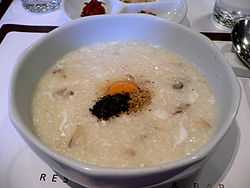Juk (food)
| Juk | |
|---|---|
| Congee | |
 | |
| Place of origin: | |
| Korea | |
| Serving temperature: | |
| Warm | |
| Main ingredient(s): | |
| Cereal | |
| Recipes at Wikibooks: | |
|
| |
| Media at Wikimedia Commons: | |
|
|
Juk is a predominantly Korean porridge made of grains such as cooked rice, beans, sesame, and azuki beans.[1] It is also a common food in other Eastern Asian countries under different names.[2] Juk is often eaten warm in Korea, especially as a morning meal, but is now eaten at any time of the day.[1]
It is known to have nutritional benefits, and is considered to be beneficial to digestion because of its soft texture. It is a staple "get well" dish; a dish to eat when one is sick or recovering from bad health.[3] Juk is also considered an ideal food for babies,[4] and is sold commercially by many juk chain stores in South Korea.[5]
Variations
There are more than forty varieties of juk mentioned in old documents.[6] The most general form of juk is simply called heen juk (흰죽, white juk), which is made from plain white rice. Being largely unflavored, it is served together with a number of more flavorful side dishes such as jeotgal, various types of kimchi, pickled cuttlefish, spicy octopus, and other side-dishes. Other varieties include different ingredients such as milk, vegetables, seafood, nuts and other grains.


- Sok mieum (속미음): sweet rice, red jujubes, ginseng root, and chestnuts are simmered.[7]
- Jatjuk(잣죽) : rice is soaked and pine nuts are finely ground before being boiled in water.
- Jeonbokjuk(전복죽) : sliced abalones are cooked together with ground rice
- Yulmujuk (율무죽) : made from ground Job's Tears
- Patjuk(팥죽) : made from red azuki beans
- Hobakjuk(호박죽) : pumpkin is simmered till soft, mashed and cooked with glutinous rice
- Omija eungi (오미자응이): Mung bean starch is added to boiled omija water and simmered.[8]
See also
References
- ↑ 1.0 1.1 An Illustrated Guide to Korean Culture - 233 traditional key words. Seoul: Hakgojae Publishing Co. 2002. pp. 20–21. ISBN 8985846981.
- ↑ Congee
- ↑ "Rice porridge (Juk) A Practical source of nutrition" Paik Jae-Eun, professor of food and nutrition, Bucheon College, 2008 Spring Koreana. Retrieved 2010-06-16
- ↑ (Korean)"Food industry eyes baby market", Newsis Health 2010-03-30
- ↑ (Korean) "Busy juk restaurants", City News 2010-05-17
- ↑ (Korean) Juk Doosan Encyclopedia
- ↑ (Korean) Sok mieum at Doosan Encyclopedia
- ↑ (Korean) Omija eungi at Doosan Encyclopedia
External links
| Wikimedia Commons has media related to Juk. |